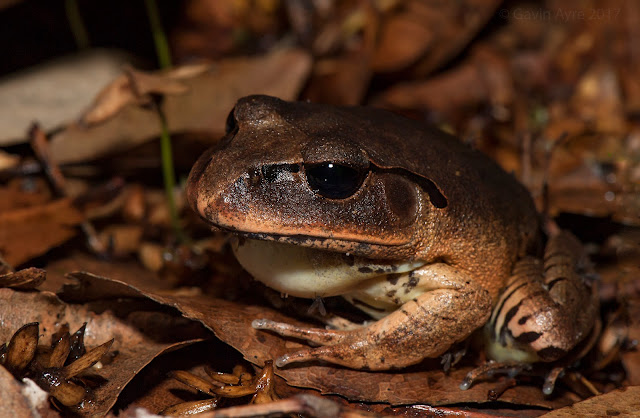 |
| Great barred frog, Mixophyes fasciolatus, lower Hunter valley, NSW, February 2017 Note the biting midges on this animals' back |
Look at the posture of this animal - notice how his eyes are pulled down into his head? This is their response to being illuminated by a torch beam. It never ceases to amaze me how such a large frog will disappear when they pull their eyes in. One moment they are sitting there in the open, eyes ablaze. If you look away for a sec and shine your torch back, suddenly they've vanished into thin air. But keep looking and your mind will process the scene and mysteriously the frog will eventually re-appear, in exactly the same place, looking like this. It's a particularly clever adaptation to hide from people !
This is the most common species of the Mixophyes genus in the lower Hunter Valley, the Great barred frog, Mixophyes fasciolatus. I didn't realise at the time, but this animal had some sort of midge biting it's back. This is of particular interest because of the possibility for transmission of the Chytrid fungus.
I can't help but wonder if this might be a potential pathway the fungus used to spread so far and wide, and devastate vulnerable populations so rapidly. In all my many decades of herpetology, I cannot remember seeing many photos of frogs with biting midges like I have seen recently.
This might be very easily explained because until frogs populations were endangered globally, many herpetologists considered frogs pretty boring, and were particularly interested in catching them for use as food for their elapid snakes, rather than photographing them. For example, Litoria flavipunctata was often collected to feed to copperheads and tiger snakes at Mother of Ducks lagoon back in the 70's and 80's by local herpetologists. It wasn't until they had vanished without trace that people realised exactly how special they were, and what an important species we've lost.
Most herpetologists that I knew didn't bother spending much time trying to photograph frogs, and the availability of cheap, extremely high quality camera gear just wasn't there. I certainly would not take my gear out on rainy nights when frogs were most active for fear of damaging my equipment.
The risk of accidental transmission by people handling frogs is very real (and why I will never touch a frog I'm photographing these days), but there has to be a mechanism to spread such a virulent pathogen so quickly and widely. A biting midge might very well be the mechanism that spread the fungus so widely so quickly, getting blown between drainage systems. An analogue would be Ross river fever, Barmah Forest virus etc for people. Population booms in mosquitoes result in massive outbreaks in people as the mosquitoes get blown to other areas.
 |
| Another Great barred frog, Mixophyes fasciolatus, lower Hunter valley, NSW, February 2017 Note this animal also has biting midges on it's throat and back |
 |
| Great barred frog, Mixophyes fasciolatus, lower Hunter valley, NSW, February 2017 Same animal as photo above. Note this animal also has biting midges on it's throat and back |
No comments:
Post a Comment